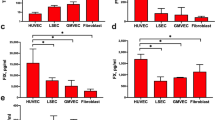Abstract
The effects of endotoxin-triggered granulocytes on the viability of endothelial cells in vitro was investigated. Endotoxin or its lipid A component caused granulocytes to adhere to and significantly damage cultured endothelial cells. Fresh serum is not necessary but does amplify both adherence and endothelial injury. Much of the endothelial injury was inhibited by free-radical scavengers or by blocking granulocyte adhesion to endothelial cells and appears to result from free radical production by the stimulated granulocyte. Studies in this model suggest a pathogenic role for the endotoxin-triggered granulocyte in the Shwartzman reaction and perhaps related clinical disorders.
Similar content being viewed by others
References
Sandritter, W. C., C. M. Hermayer, U. N. Riede, N. Freudenberg, andH. Grimm. 1978. The shock lung syndrome (an overview).Pathol. Res. Pract. 162:7–23.
Schweinburg, F. B., R. G. Smiddy, andJ. Fine. 1959. The granulocytopenic response in hemorrhagic shock.J. Clin. Invest. 38:673–679.
Elin, R. J., andS. M. Wolff. 1976. Biology of endotoxin.Ann. Rev. Med. 27:127–141.
Shwartzman, G., P. Klemperer, andI. E. Gerber. 1936. The phenomenon of local tissue reactivity to bacterial filtrates.J. Am. Med. Assoc. 107:1946–1951.
Good, R. A., andL. Thomas. 1953. Studies on the generalized Shwartzman reaction. IV. Prevention of the local and generalized Shwartzman reaction with heparin.J. Exp. Med. 97:871–881.
Levin, J., andE. Beck. 1966. A reappraisal of the role of blood coagulation and platelets in the generalized Shwartzman phenomenon.Thrombos. Diathes. Haemorrh. 15:519–522.
Gaynor, E., C. Bouvier, andT. H. Spaet. 1970. Vascular lesions: Possible pathogenetic basis of the generalized Shwartzman reaction.Science 170:986–988.
Horn, R. G. 1973. Evidence for participation of granulocytes in the pathogenesis of the generalized Shwartzman reaction: A review.J. Infect. Dis. 128:134–143.
Stetson, C. A., andR. A. Good. 1951. Studies on the generalized Shwartzman reaction. Evidence for the participation of PMNs in the phenomenon.J. Exp. Med. 93:49–51.
Sacks, T., C. F. Moldow, C. R. Craddock, T. K. Bowers, andH. S. Jacob. 1978. Oxygen radicals mediate endothelial cell damage by complement-stimulated granulocytes.J. Clin. Invest. 61:1161–1167.
Jaffe, E. A., L. W. Hoyer, andR. L. Nachman. 1973. Synthesis of antihemophilic factor antigens by cultured human endothelial cells.J. Clin. Invest. 52:2757–2764.
Jaffe, E. A., R. L. Nachman, C. G. Becker, andC. R. Minick. 1973. Culture of human endothelial cells derived from umbilical veins.J. Clin. Invest. 52:2745–2756.
Boyum, A. 1968. Isolation of mononuclear cells and granulocytes from human blood. Isolation of mononuclear cells by one centrifugation; and granulocytes by combining centrifugation and sedimentation at lg.Scand. J. Clin. Lab. Invest. 21 (Suppl. 97):77–89.
Galanos, C., E. T. Rietschel, O. Lüderitz, andO. Westphal. 1971. Interaction of lipopolysaccharide and lipid A with complement.Eur. J. Biochem. 19:143–152.
Galanos, C., E. T. Rietschel, O. Lüderitz, andO. Westphal. 1972. Biological activities of Lipid A complexed with bovine serum albumin.Eur. J. Biochem. 31:230–233.
Rickles, F. R., andP. D. Rick. 1977. Structural features ofSalmonella typhimurium lipopolysaccharides required for activation of tissue factor in human mononuclear cells.J. Clin. Invest. 59:1188–1195.
Celada, F., andB. Rotman. 1967. A fluorochromatic test for immunocytotoxicity against tumor cells and leukocytes in agarose plates.Proc. Natl. Acad. Sci. U.S.A. 57:630–636.
Rotman, B., andB. X. Papermaster. 1966. Membrane properties of living mammalian cells as studied by enzymatic hydroloysis of fluorogenic esters.Proc. Natl. Acad. Sci. U.S.A. 55:134–141.
Fehr, J., andH. S. Jacob. 1977.In vitro granulocyte adherence andin vivo margination: Two associated complement-dependent functions.J. Exp. Med. 146:641–652.
Goldstein, I. M., D. Ross, H. B. Kaplan, andG. Weissmann. 1975. Complement and immunoglobulins stimulate Superoxide production by human leukocytes independently of phagocytosis.J. Clin. Invest. 56:1155–1163.
Root, R. K., B. Metcalf, N. Ochino, andB. Chance. 1975. H2O2 release from human granulocytes during phagocytosis.J. Clin. Invest. 55:945–955.
Tsan, M., K. H. Douglass, andP. A. McIntyre. 1977. Hydrogen peroxide productions and killing of staphylococcus aureus by human polymorphonuclear leukocytes.Blood. 49:437–443.
Hammerschmidt, D. E., J. G. White, P. R. Craddock, andH. S. Jacob. 1979. Corticosteroids inhibit complement-induced granulocyte aggregation.J. Clin. Invest. 63:798–803.
Zigmond, S. M., andJ. G. Hirsch. 1972. Effects of cytochalasin B on polymorphonuclear leukocyte locomotion, phagocytosis, and glycolysis.Exp. Cell Res. 73:383–393.
Martz, E., S. J. Burakoff, andB. Benacerraf. 1974. Interruption of the sequential release of small and large molecules from tumor cells by low temperature during cytolysis mediated by immune T-cells or complement.Proc. Natl. Acad. Sci. U.S.A. 71:177–181.
Wall, R. T., J. M. Harlan, L. A. Harker, andG. E. Striker. 1977. Endotoxin mediated vascular injury.Blood 50: (suppl. 1):286.
Niemetz, J., andD. C. Morrison. 1977. Lipid A as the biologically active moiety in bacterial endotoxin (LPS)-initiated generation of procoagulant activity by peripheral blood leukocytes.Blood 49:947–956.
Galanos, C., O. Lüderitz, E. T. Rietschel, andO. Westphal. 1977. Newer aspects of the chemistry and biology of the bacterial lipopolysaccharides, with special reference to their lipid A component.Int. Rev. Biochem. 14:235–335.
Morrison, D. C., andL. F. Kline. 1977. Activation of the classical and properdin pathways of complement by bacterial lipopolysaccharides (LPS.).J. Immunol. 118:362–370.
Nowotny, A., U. H. Behling, andH. L. Chang. 1975. Relation of structure to function in bacterial endotoxins. VIII. Biological activities in a polysaccharide-rich fraction.J. Immunol.115:199–203.
Loos, M., D. Bitter-Suermann, andM. Dierich. 1974. Interaction of the first (C1), the second (C2), and the fourth (C4) component of complement with different preparations of bacterial lipopolysaccharides (LPS)J. Immunol. 112:935–944.
Morrison, D. C., andC. G. Cochrane. 1974. Direct evidence for Hagerman factor(factor XII) activation by bacterial lipopolysaccharides (endotoxins).J. Exp. Med. 140:797–806.
Doe, W. F., S. T. Yang, D. C. Morrison, S. J. Betz,andP. M. Henson. 1978. Macrophage stimulation by bacterial lipopolysaccharides.J. Exp. Med. 148:557–568.
Brigham, K. L., W. C. Woolverton, L. H. Blake, andN. C. Staub. 1974. Increased sheep lung vascular permeability caused by pseudomonas bacteremia.J. Clin. Invest. 54: 792–804.
Goldstein, I. M., D. Ross, G. Weissmann, andH. B. Kaplan. 1976. Influence of corticosteroids on human polymorphonuclear leukocyte function in vitro.Inflammation 1:305–315.
Author information
Authors and Affiliations
Rights and permissions
About this article
Cite this article
Yamada, O., Moldow, C.F., Sacks, T. et al. Deleterious effects of endotoxin on cultured endothelial cells: An in vitro model of vascular injury. Inflammation 5, 115–126 (1981). https://doi.org/10.1007/BF00914201
Issue Date:
DOI: https://doi.org/10.1007/BF00914201




